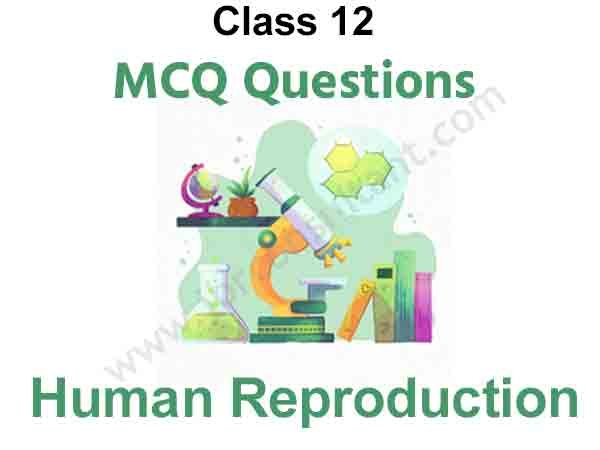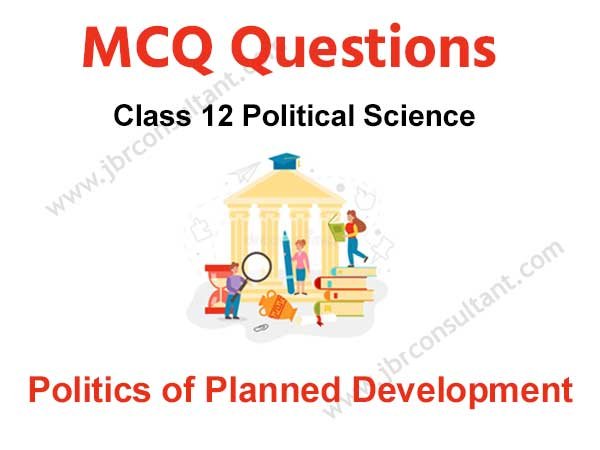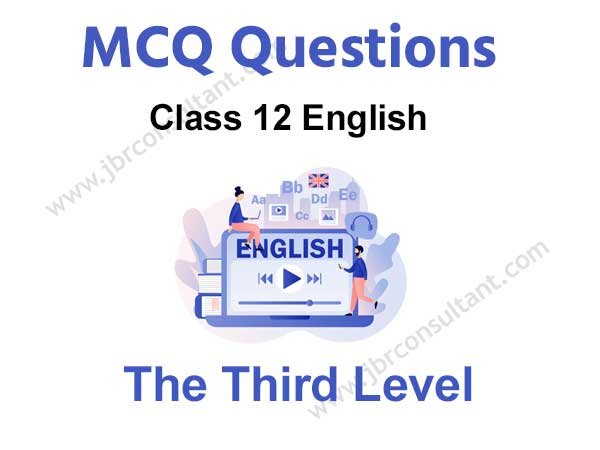Human Reproduction Class 12 MCQ Questions is one of the best strategies to prepare for the CBSE Class 12 Board exam. If you want to complete a grasp concept or work on one’s score, there is no method except constant practice. Students can improve their speed and accuracy by doing more Human Reproduction Class 12 Biology Chapter 3 MCQ, which will help them all through their board test.
Human Reproduction Class 12 MCQ Questions with Answers
Class 12 Biology MCQ with answers are given here to chapter 3 Human Reproduction. These MCQs are based on the latest CBSE board syllabus and relate to the latest Class 12 Biology syllabus. By Solving these Class 12 MCQ, you will be able to analyze all of the concepts quickly in the chapter and get ready for the Class 12 Annual exam.
Learn Human Reproduction Class 12 MCQ with answers pdf free download according to the latest CBSE and NCERT syllabus. Students should prepare for the examination by solving MCQ on Human Reproduction Class 12 Pdf with answers given below.
Question 1. The shared terminal duct of the reproductive and urinary system in the human male is
(a) urethra
(b) ureter
(c) vas deferens
(d) vasa efferentia.
Answer
A
Question 2. The extra-embryonic membranes of mammalian embryo are derived from
(a) trophoblast
(b) follicle cells
(c) inner cell mass
(d) formative cells
Answer
A
Question 3. What is true for cleavage?
(a) Size of embryo increases
(b) Size of cells decreases
(c) Size of cells increases
(d) Size of embryo decreases
Answer
B
Question 4. In human female, the blastocyst
(a) forms placenta even before implantation
(b) gets implanted into uterus 3 days after ovulation
(c) gets nutrition from uterine endometrial secretion only after implantation
(d) gets implanted in endometrium by the trophoblast cells.
Answer
D
Question 5. After ovulation Graafian follicle regresses into
(a) corpus artesia
(b) corpus callosum
(c) corpus luteum
(d) corpus albicans.
Answer
C
Question 6. Sertoli cells are found in
(a) ovaries and secrete progesterone
(b) adrenal cortex and secrete adrenaline
(c) seminiferous tubules and provide nutrition to germ cells
(d) pancreas and secrete cholecystokinin.
Answer
C
Question 7. The Leydig’s cells as found in the human body are the secretory source of
(a) progesterone
(b) intestinal mucus
(c) glucagon
(d) androgens.
Answer
D
Question 8. Both corpus luteum and macula lutea are
(a) found in human ovaries
(b) a source of hormones
(c) characterized by a yellow colour
(d) contributory in maintaining pregnancy
Answer
C
Question 9. Spot the odd one out from the following structures with reference to the male reproductive system.
(a) Rate testis
(b) Epididymis
(c) Vasa efferentia
(d) Isthmus
Answer
D
Question 10. In an egg, the type of cleavage is determined by
(a) the amount and distribution of yolk
(b) the number of egg membranes
(c) the shape and size of the sperm
(d) the size and location of the nucleus.
Answer
C
Question 11. Secretions from which one of the following are rich in fructose, calcium and some enzymes?
(a) Male accessory glands
(b) Liver
(c) Pancreas
(d) Salivary glands
Answer
A
Question 12. Location and secretion of Leydig’s cells are
(a) liver-cholesterol
(b) ovary-estrogen
(c) testis-testosterone
(d) pancreas-glucagon.
Answer
C
Question 13. The main function of mammalian corpus luteum is to produce
(a) estrogen only
(b) progesterone
(c) human chorionic gonadotropin
(d) relaxin only.
Answer
B
Question 14. A human female reaches menopause aroung the age of
(a) 50 years
(b) 15 years
(c) 70 years
(d) 25 years.
Answer
A
Question 15. Meroblastic cleavage is a division which is
(a) horizontal
(b) partial/parietal
(c) total
(d) spiral.
Answer
B
Question 16. Women who consumed the drug thalidomide for relief from vomiting during early months of pregnancy gave birth to children with
(a) no spleen
(b) hare-lip
(c) extra fingers and toes
(d) under developed limbs
Answer
D
Question 17. Which one of the following is the most likely root cause why menstruation is not taking place in regularly cycling human female?
(a) Maintenance of the hypertrophical endometrial lining
(b) Maintenance of high concentration of sexhormones in the blood stream
(c) Retention of well-developed corpus luteum
(d) Fertilisation of the ovum
Answer
B
Question 18. Which of the following is true regarding sperm?
(a) Fertilizin: For penetrating egg membrane
(b) Hyalurodinase: For penetrating egg membrane
(c) Acrosin: Dissolves corona radiata
(d) Capacitation: Takes place in penis
Answer
B
Question 19. Withdrawal of which of the following hormones is the immediate cause of menstruation?
(a) Progesterone
(b) Estrogen
(c) FSH
(d) FSH-RH
Answer
A
Question 20. The first movements of the fetus and appearance of hair on its head are usually observed during which month of pregnancy?
(a) Fourth month
(b) Fifth month
(c) Sixth month
(d) Third month
Answer
B
Whoever needs to take the CBSE Class 12 Board Exam should look at this MCQ. To the Students who will show up in CBSE Class 12 Biology Board Exams, It is suggested to practice more and more questions. Aside from the sample paper you more likely had solved. These Human Reproduction Class 12 MCQ are ready by the subject specialists themselves.
Question 21. What happens during fertilisation in humans after many sperms reach close to the ovum?
(a) Secretions of acrosome helps one sperm enter cytoplasm of ovum through zona pellucida.
(b) All sperms except the one nearest to the ovum lose their tails.
(c) Cells of corona radiata trap all the sperms except one.
(d) Only two sperms nearest the ovum penetrate zona pellucida.
Answer
A
Question 22. The part of Fallopian tube closest to the ovary is
(a) isthmus
(b) infundibulum
(c) cervix
(d) ampulla
Answer
B
Question 23. Sperm and egg nuclei fuse due to
(a) base pairing of their DNA and RNA
(b) formation of hydrogen bonds
(c) mutual attraction due to differences in electrical charges
(d) attraction of their protoplasts.
Answer
D
Question 24. Meroblastic cleavage refers to which type of division of egg
(a) Complete
(b) Spiral
(c) Incomplete
(d) Horizontal
Answer
C
Question 25. All of the following statements concerning pregnancy are accurate EXCEPT
(a) the detection of human chorionic gonadotropin in the urine forms the basis for pregnancy tests.
(b) the cyclic release of pituitary gonadotropins and ovarian steroids is continued.
(c) the mammary gland tissue of the pregnant woman is stimulated to develop by placental hormones.
(d) the corpus luteum of pregnancy maintains the uterus until the placenta is well established.
Answer
B
Question 26. Changes in GnRH pulse frequency in females is controlled by circulating levels of
(a) progesterone only
(b) progesterone and inhibin
(c) estrogen and progesterone
(d) estrogen and inhibin.
Answer
C
Question 27. Hormones secreted by the placenta to maintain pregnancy are
(a) hCG, hPL, progestogens, prolactin
(b) hCG, hPL, estrogens, relaxin, oxytocin
(c) hCG, hPL, progestogens, estrogens
(d) hCG, progestogens, estrogens, glucocorticoids.
Answer
C
Question 28. The difference between spermiogenesis and spermiation is
(a) in spermiogenesis spermatids are formed, while in spermiation spermatozoa are formed
(b) in spermiogenesis spermatozoa are formed, while in spermiation spermatids are formed
(c) in spermiogenesis spermatozoa from Sertoli cells are released into the cavity of seminiferous tubules, while in spermiation spermatozoa are formed
(d) in spermiogenesis spermatozoa are formed, while in spermiation spermatozoa are released from Sertoli cells into the cavity of seminiferous tubules.
Answer
D
Question 29. Egg is liberated from ovary in
(a) secondary oocyte stage
(b) primary oocyte stage
(c) oogonial stage
(d) mature ovum stage.
Answer
A
Question 30 .Ovulation in the human female normally takes place during the menstrual cycle
(a) at the mind secretory phase
(b) just before the end of the secretory phase
(c) at the beginning of the proliferative phase
(d) at the end of the proliferative phase.
Answer
D
Question 31. Which one of the following statements is false in respect of viability of mammalian sperm?
(a) Sperm is viable for only up to 24 hours.
(b) Survival of sperm depends on the pH of the medium and is more active in alkaline medium.
(c) Viability of sperm is determined by its motility.
(d) Sperms must be concentrated in a thick suspension.
Answer
A
Question 32. In human females, meiosis-II is not completed until
(a) uterine implantation
(b) birth
(c) puberty
(d) fertilisation.
Answer
D
Question 33. In humans, at the end of the first meiotic division,the male germ cells differentiate into the
(a) spermatids
(b) spermatogonia
(c) primary spermatocytes
(d) secondary spermatocytes.
Answer
D
Question 34. The membranous cover of the ovum at ovulation is
(a) corona radiate
(b) zona radiata
(c) zona pellucida
(d) chorion.
Answer
A
Question 35. Seminal plasma in humans is rich in
(a) fructose and calcium but has no enzymes
(b) glucose and certain enzymes but has no calcium
(c) fructose and certain enzymes but poor in calcium
(d) fructose, calcium and certain enzymes.
Answer
D
Question 36. The extra embryonic membranes of the mammalian embryo are derived from
(a) trophoblast
(b) inner cell mass
(c) formative cells
(d) follicle cells.
Answer
A
Question 37. Extrusion of second polar body from egg occurs
(a) simultaneously with first cleavage
(b) after entry of sperm but before fertilisation
(c) after fertilisation
(d) before entry of sperm into ovum.
Answer
B
Question 38. In spermatogenesis, reduction division of chromosome occurs during conversion of
(a) spermatogonia to primary spermatocytes
(b) primary spermatocytes to secondary spermatocytes B
(c) secondary spermatocytes to spermatids
(d) spermatids to sperms.
Answer
B
Question 39. 1st polar body is formed at which stage of oogenesis ?
(a) 1st meiosis
(b) 2nd mitosis
(c) 1st mitosis
(d) Differentiation
Answer
A
Question 40. The fetal ejection reflex in humans triggers the release of
(a) oxytocin from fetal pituitary
(b) human chorionic gonadotropin (hCG) from placenta
(c) human placental lactogen (hPL) from placenta
(d) oxytocin from maternal pituitary.
Answer
D

You can easily get good marks If you study with the help of Human Reproduction Class 12 MCQ. We trust that information provided is useful for you. NCERT MCQ on Human Reproduction Class 12 PDF Free Download would without a doubt create positive results.
We hope the information shared above in regards to Human Reproduction Class 12 MCQ with Answers has been helpful to you. if you have any questions regarding CBSE Class 12 Biology Chapter 3 MCQ Pdf, write a comment below and we will get back to you as soon as possible.
Frequently Asked Questions FAQs
How many MCQ questions are there in CLass 12 chapter 3 Biology?
In Class 12 chapter 3 Biology, we have provided 40 Important MCQ Questions, But in the future, we will add more MCQs so that you can get good marks in the Class 12 exam.
Can we score good marks in Class 12 Biology for Human Reproduction with the help of MCQ Questions?
Yes, MCQ Question is one of the best strategies to make your preparation better for the CBSE Board Exam. It also helps to know the student’s basic understanding of each chapter. So, You can score good marks in the Class 12 BIology exam.


